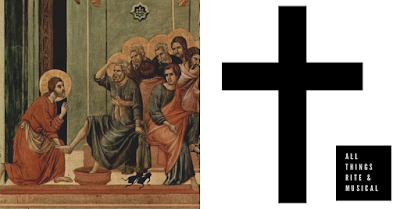Maundy Thursday & Good Friday (encores)
A rebroadcast of our Maundy Thursday and Good Friday episodes, which were both part of our Holy Week series.
Download this episode (mp3).
- Neil Alexander on Maundy Thursday using white and other festal elements: "Keeping Maundy Thursday as a feast of the institution of the Eucharist has centuries of precedence, but not always with the same meaning. Because of the centrality of the Eucharist in the church's life, Maundy Thursday has been celebrated with a meaningful degree of festivity, almost a day out of time that nearly sets aside the fact that the day is the fulcrum between the fast of Lent and the fast before Easter. This tradition brings out the white vestments and paraments, sings the Gloria in excelsis, and in its more severe rendering reintroduces, albeit temporarily, the Alleluia and other aspects of the rites associated with a festal occasion, not a ritual move from one fast to another." (Alexander, J. Neil. 2014. Celebrating Liturgical Time: Days, Weeks, and Seasons. New York: Church Publishing. 111-12.)
- Original options for the Maundy Thursday Gospel reading in the 1979 BCP are John 13:1-15 or Luke 22:14-30. The Episcopal RCL Gospel reading for Maundy Thursday is John 13:1-17, 31b-35. This adds the following verses to the original reading:
"Very truly, I tell you, servants are not greater than their master, nor are messengers greater than the one who sent them. If you know these things, you are blessed if you do them.
Jesus said, ‘Now the Son of Man has been glorified, and God has been glorified in him. If God has been glorified in him, God will also glorify him in himself and will glorify him at once. Little children, I am with you only a little longer. You will look for me; and as I said to the Jews so now I say to you, “Where I am going, you cannot come.” I give you a new commandment, that you love one another. Just as I have loved you, you also should love one another. By this everyone will know that you are my disciples, if you have love for one another.’" (NRSV, emphasis added) - "As we know from later liturgical sources, however, a footwashing rite called the Pedilavium does become an important part of the rites of Christian initiation in a number of different places such as Milan, North Africa, Spain, Gaul, and Syria." (Johnson, Maxwell E. 2007. The Rites of Christian Initiation: Their Evolution and Interpretation, Revised and Expanded Edition. Collegeville: Liturgical Press. 21.)
- The Book of Occasional Services 2003 contains rubrics for the foot washing, reserving the sacrament, and stripping the altar on pages 93-4. The "Agapé for Maundy Thursday" follows, on 95-6.
Thanks for listening! We always enjoy hearing from you. You can find us on Facebook and Twitter. You can email us at riteandmusical@gmail.com
If you enjoy listening to this podcast, we encourage you to help support it. Become a Patron for $1 a month (that's about 50¢ an episode).
Subscribe to the podcast via iTunes, Spotify, Stitcher, Google Play, TuneIn, or our feed.



Comments
Post a Comment
We want everyone to comment, and please sign your real name when you do.